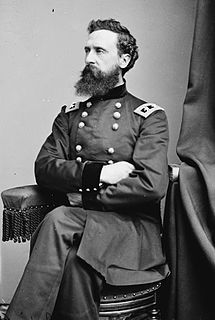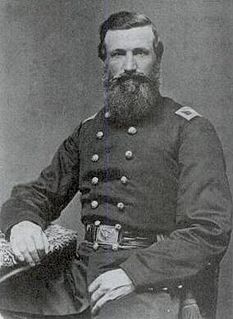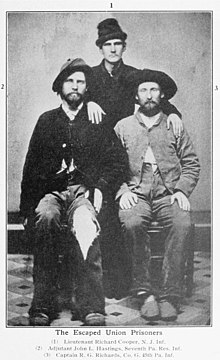The Union order of battle during the Battle of Gettysburg includes the American Civil War officers and men of the Army of the Potomac . Order of battle compiled from the army organization during the battle, the casualty returns and the reports.
The Irish Brigade was an infantry brigade, consisting predominantly of Irish Americans, that served in the Union Army in the American Civil War. The designation of the first regiment in the brigade, the 69th New York Infantry, or the "Fighting 69th", continued in later wars. The Irish Brigade was known in part for its famous war cry, the "Faugh a Ballaugh", which is an anglicization of the Irish phrase, fág an bealach, meaning "clear the way" and used in various Irish-majority military units founded due to the Irish diaspora. According to Fox's Regimental Losses, of all Union army brigades, only the 1st Vermont Brigade and Iron Brigade suffered more combat dead than the Irish Brigade during America's Civil War.

George Sykes was a career United States Army officer and a Union General during the American Civil War.

XXII Corps was a corps in the Union Army during the American Civil War. It was created on February 2, 1863, to consist of all troops garrisoned in Washington, D.C., and included three infantry divisions and one of cavalry. Many of its units were transferred to the Army of the Potomac during Grant's Overland Campaign.
The 14th Indiana Infantry Regiment, later referred to as the Gallant Fourteenth, was an infantry regiment and part of the Union Army's celebrated "Gibraltar Brigade" of the Army of the Potomac during the American Civil War. Organized in May 1861 at Camp Vigo, near Terre Haute, Indiana, it was the state's first regiment organized for three years of service. The 14th Indiana served in major campaigns and battles in the Eastern Theater, mostly in West Virginia, Virginia, Pennsylvania, and Maryland. During its three years of service, the regiment had a total of 222 casualties.
William McCandless was an American military officer and politician from Pennsylvania. He served in the Union Army during the American Civil War and commanded a regiment and then a brigade in the Pennsylvania Reserve Division. He served as a Democratic member of the Pennsylvania State Senate for the 1st district from 1867 to 1868 and as the first Secretary of Internal Affairs of Pennsylvania from 1875 to 1879.
Battery H, 1st Ohio Light Artillery was an artillery battery that served in the Union Army during the American Civil War. It was also known as Huntington's Battery.

Peter Hollingshead Allabach was an officer in the Union Army during the American Civil War.

Battery F, 1st Pennsylvania Light Artillery was a light artillery battery that served in the Union Army as part of the Pennsylvania Reserves infantry division during the American Civil War.

The 1st Pennsylvania Reserve Regiment, also known as the 30th Pennsylvania Volunteer Infantry, was a regiment in the Union Army during the American Civil War. It was a part of the famed Pennsylvania Reserve division in the Army of the Potomac for much of the war, and served in the Eastern Theater in a number of important battles, including Antietam, Fredericksburg, and Gettysburg.
The 12th Pennsylvania Reserve Regiment also known as the 41st Pennsylvania Volunteer Infantry was an infantry regiment that served in the Union Army as part of the Pennsylvania Reserves infantry division during the American Civil War.
The 6th Pennsylvania Reserve Regiment also known as the 35th Pennsylvania Volunteer Infantry was an infantry regiment that served in the Union Army as part of the Pennsylvania Reserves Infantry Division during the American Civil War.

Independent Battery "C", Pennsylvania Volunteers was a light artillery battery that served in the Union Army during the American Civil War.
Battery B, 1st Pennsylvania Light Artillery was a light artillery battery that served in the Union Army as part of the Pennsylvania Reserves infantry division during the American Civil War.
Battery "A" 4th Regiment of Artillery was a light artillery battery that served in the Union Army during the American Civil War.
The 5th Independent Battery, New York Volunteer Light Artillery or 5th New York Independent Light Artillery was an artillery battery that served in the Union Army during the American Civil War.
Battery "G" 4th Regiment of Artillery was a light artillery battery that served in the Union Army during the American Civil War.
The Battery A, Maryland Light Artillery, was an artillery battery that served in the Union Army during the American Civil War. It briefly served as infantry from July 3, 1864 until March 11, 1865.
The 109th Pennsylvania Volunteer Infantry was an infantry regiment that served in the Union Army during the American Civil War.

Independent Battery F, Pennsylvania Light Artillery, also known as the "Pittsburg Battery", was an artillery battery that served in the Union Army during the American Civil War. Organized in December 1861, the unit first served in the Shenandoah Valley. Battery F fought at Hancock, Winchester, Sulphur Springs, Second Bull Run, Chantilly, and Antietam in 1862. The following year the unit fought at Chancellorsville, Gettysburg, the Bristoe Campaign, and Mine Run. In 1864–1865, Battery F fought at Morton's Ford and served in the garrisons of Washington, D.C. and Harper's Ferry, West Virginia before being mustered out in June 1865. One enlisted man from the battery won the Medal of Honor for heroic action at Gettysburg.








